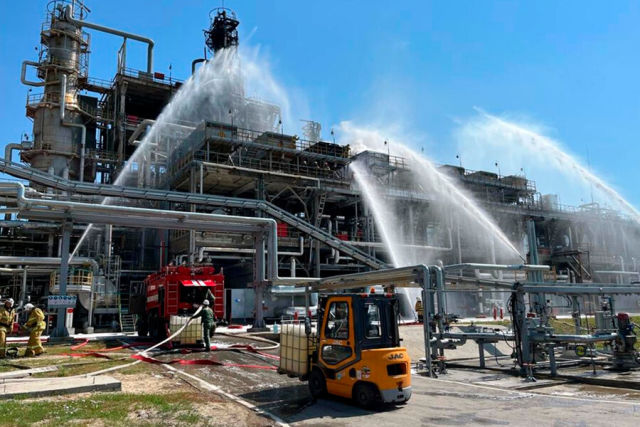Colonel Khodarenok told how to prevent Ukrainian UAV strikes on Russian territory
Novoshakhtinsky Oil Products Plant (NZNP), located in the Krasnosulinsky district of the Rostov region, was attacked by two Ukrainian unmanned aerial vehicles (UAVs) this week. Human casualties were avoided. How to build an effective system of protection against drones - in the author's material of the military observer "Gazeta.Ru" by Mikhail Khodarenka.
"As a result of terrorist actions from the western border of the Rostov region, two unmanned aerial vehicles were struck at the technological facilities of the Novoshakhtinsky Oil Products Plant joint stock company, as a result of which an explosion occurred," the plant's press service said.
The first blow fell on the technological equipment of the oil refining plant, the second - on the objects of the tank farm. According to the press service of the company, there were no casualties, and the fire was localized.
Novoshakhtinsky Oil Products Plant with a design capacity of up to 7.5 million tons of oil per year was commissioned in 2009 and is the only operating oil refinery in the Rostov region. The plant specializes in the production and sale of fuel oil, furnace, marine and diesel fuel, straight-run gasoline.
According to the Minister of Energy of the Russian Federation Nikolay Shulginov, the fire at the Novoshakhtinskoye refinery did not affect the supply of gasoline and diesel fuel to consumers in the south of Russia. "The plant did not supply commercial motor fuel to the domestic market and is currently undergoing modernization," Shulginov said.
The question arises - how to secure the most important Russian infrastructure facilities in the south-western strategic direction in order to prevent such attacks in the future?
First of all, it should be emphasized that against the background of the attack on the Novoshakhtinsky Oil Products Plant, any accusations against domestic anti-aircraft missile and radar weapons about their alleged "inability" to resist UAVs have no basis.
The Pantsir-S1 anti-aircraft missile and cannon complex (ZRPC), the Tor tactical anti-aircraft missile system (SAM) have repeatedly shown the highest efficiency in the confrontation with UAVs - in Syria, Libya, Ukraine, and other countries.
The promising anti-aircraft artillery complex "Derivation-Air Defense", which is now completing tests, also seems to be an extremely effective tool. It is equipped with "smart" explosive shells that explode next to the UAV and are guaranteed to hit even the smallest drone with fragments.
As for the kamikaze drones of the Armed Forces of Ukraine that attacked the NZNP, then, with a high degree of probability, it was either a small Ukrainian PD-1 unmanned aerial vehicle, or a modified Chinese Skyeye 4450 drone, which is on free sale. Both could have been loaded with explosives.
So, first of all, it is necessary to strengthen the radar reconnaissance system in the region. The lower limit of the radar field in this case should be no more than 50 m. It is at this height that it is necessary to ensure stable wiring of aerial objects such as UAVs.
The most important thing is that the units of the radio-technical troops need to issue target designation as quickly as possible to all possible firing means. The fact is that the detection range of a UAV-type target at an altitude of 50 meters in medium-terrain conditions is no more than 15-17 km. This means that it is at this distance from each other that the radar systems should be defended.
No less stringent requirements should be imposed on the anti-aircraft missile cover system.
Finally, attack helicopters should be connected to the destruction of UAVs. That is, they should be included in a single control and targeting circuit along with the SAM.
The opinion of the author may not coincide with the position of the editorial board.
Biography of the author:
Mikhail Mikhailovich Khodarenok is a military columnist for the newspaper.Ru", retired colonel.
He graduated from the Minsk Higher Engineering Anti-Aircraft Missile School (1976), the Military Air Defense Command Academy (1986).
Commander of the S-75 anti-aircraft missile division (1980-1983).
Deputy Commander of the anti-aircraft missile regiment (1986-1988).
Senior Officer of the General Staff of the Air Defense Forces (1988-1992).
Officer of the Main Operational Directorate of the General Staff (1992-2000).
Graduated from the Military Academy of the General Staff of the Armed Forces of Russia (1998).
Columnist of "Nezavisimaya Gazeta" (2000-2003), editor-in-chief of the newspaper "Military-Industrial Courier" (2010-2015).
Mikhail Khodarenok

